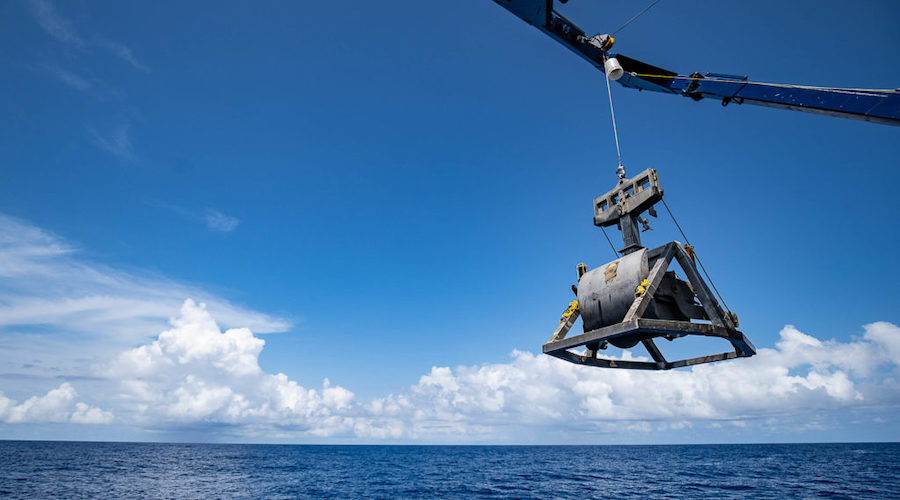The Metals Company calls video of mining waste dumped into the sea misinformation as stock sinks
Bruno Venditti | January 12, 2023 |

Image from The Metals Company
The Metals Company (NASDAQ: TMC), formerly Deep Green Metals, an explorer of lower-impact battery metals from seafloor polymetallic nodules, responded Thursday to videos of what appears to be mining waste dumped into the sea shared by environmental groups on Tuesday, saying they were taken out of context.

The videos, released by MiningWatch Canada, Greenpeace International, and the Deep Sea Mining Campaign, were captured in October by scientists aboard ships owned by the company as it trialed its deep-sea mining technology in the Clarion Clipperton Zone (CCZ) in the Eastern Pacific Ocean, between Hawaii and Mexico. The zone has been ranked by Mining Intelligence as the biggest nickel project in world in both 2021 and 2022.
Mining international waters is in the spotlight as companies and countries are looking at minerals concentrated on the ocean floor that can be used in batteries for smart phones and electric vehicles. The resource is now estimated at four megatons (Mt) measured, 341Mt indicated and 11Mt inferred mineral resources.
The two videos released Monday show deep-sea sediment overflowing into the ocean from the deck of the company’s 228-meter-long former drill ship, Hidden Gem.
In a technology description on its website, the company said sediment is expected to be discharged back onto the seafloor within a few hundred meters.
The company described the incident as “a minor overflow,” and said some sediment and fragments of nodules poured out of the separator and over the deck of the ship intermittently during a seven-to eight-hour test run.
“Due to the dynamic behavior of the airlift riser when first switched on, there was a surge in the volume of water flow which briefly exceeded the buffer capacity of the cyclone separator at the top of the riser,” the Metals Company said in a statement. “As a result, the cyclone experienced a minor overflow of water containing a small amount of sediment and nodule fragments.”
This footage from the ship was provided by The Metals Company:
“When safe to do so the test run was stopped in a controlled manner,” the company said. It added that an assessment was carried out to see if the incident could harm the marine environment but found it “did not have the potential to cause harm and was, therefore, not a reportable incident.”
“Testing was conducted and the implemented modifications to the cyclone separator proved effective. There were no further overflows during subsequent test runs,” the company said.
Catherine Coumans, MiningWatch Canada’s Asia-Pacific Program Coordinator, disagreed.
“That’s not supposed to be happening,” Coumans said in a statement. “Clearly, something went wrong here.”
Coumans said the scientists who filmed the video aboard the ship and later leaked it to the three advocacy groups were paid by The Metals Company to monitor the company’s deep sea metal-harvesting technology’s environmental footprint.
On Twitter, Greenpeace Global Project Leader Louisa Casson called the incident the latest in a “long list of reasons why we need to stop deep sea mining before it starts in 2023.”
“Unfortunately, we are used to these attacks by activists who take things out of context and try to create a sense of armageddon,” The Metals Company’s head of communications and brand Dan Porras told MINING.COM.
Mining in the deep sea is still under study but metals are abundant on the seafloor. Reserves are estimated to be worth anywhere from $8 trillion to more than $16 trillion.
Most of the metals are found in potato-sized rock-like polymetallic nodules. Millions of years old, the nodules grow by absorbing metals from the seawater, expanding slowly around the core of a shell, bone, or rock.
It is estimated that 21 billion tonnes of polymetallic nodules are resting on the ocean floor in the CCZ. Almost 20 international mining companies have contracts to explore the region which spans over 5,000 kilometers and is considered the most prolific area for ocean mining.
The Metals Company’s stock sunk nearly 12% by 3pm EST Thursday on the Nasdaq, capitalizing it at $207 million.
No comments:
Post a Comment